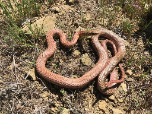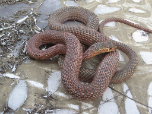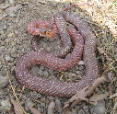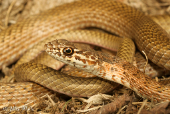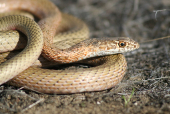San Joaquin Coachwhip (Masticophis flagellum ruddocki)
Description: Adults are 36 to 66 inches long. The only longer snake in California is the Gophersnake. Hatchlings are about 13 inches long. A slender fast-moving snake with smooth scales, a large head and eyes, a thin neck, and a long thin tail. (There is no well-defined stripe lengthwise on the body in this species.) Large scales above the eyes. 17 rows of scales at midbody. The braided appearance of scales on the tail (like a whip) gives this species its common name. Color is tan, olive brown, yellowish brown, or pinkish red. Lacks the very dark head and neckbands of the other subspecies of M. flagellum found in California.
Habitat: Occurs in open, dry, treeless areas with little or no cover, including valley grassland and saltbush scrub. Avoids dense vegetation where it cannot move quickly, including mixed oak chaparral woodland. Takes refuge in rodent burrows, under shaded vegetation, and under surface objects.
Range: This subspecies is endemic to California, ranging from the Grapevine in the Kern County portion of the San Joaquin Valley north into the inner South Coast Ranges and north to Alameda County. An isolated population occurs in Sutter County at the Sutter Buttes. Also another isolated population in Arbuckle, Colusa County. Apparently intergrades with M. f. piceus in eastern Kem County.
Found in these States:
CA
Diet: Eats small mammals including bats, nestling and adult birds, bird eggs, lizards, snakes, amphibians, and carrion. Hatchlings and juveniles will eat large invertebrates. The ability to tolerate high temperatures enables this snake to hunt heat-dependant lizards when they are active. High speed allows it to run down the fast-moving lizards. Hunts crawling with head the held high above the ground, occasionally moving it from side to side to aid in binocular vision and depth perception. The prey is overcome and crushed with the jaws or crushed beneath loops of the body then eaten without constriction.
Reproduction: Presumably mates in May. Females are oviparous, laying a clutch of 4 to 20 eggs in early Summer (June to July).
Status: Designated a Species of Special Concern by the state of California due to extensive habitat loss and fragmentation in its restricted range, including conversion of large areas of suitable habitat to agricultural use in the San Joaquin Valley and urban development in areas of the inner Coast Ranges, both of which eliminate the snake's food base and the mammal burrows it uses for refuge. Much of this subspecies' historic range has undergone dramatic land use changes from grassland to intensive agriculture in the Central Valley. Masticophis flagellum ruddocki is thought to be sensitive to disturbance and does not persist in cultivated areas. It has therefore suffered a severe range contraction in its Central Valley range.
»» Kingdom: Animalia - Animals
»» Phylum: Chordata - Chordates
»» Subphylum: Vertebrata - Vertebrates
»» Class: Reptilia - Reptiles
»» Order: Squamata - Scaled Reptiles
»» Suborder: Serpentes
»» Superfamily: Colubroidea
»» Family: Colubridae - Colubrids
»» Genus: Masticophis
»» Species: Masticophis flagellum - Coachwhip Snakes
»» Subspecies: Masticophis flagellum ruddocki - San Joaquin Coachwhip
This article uses material from the Wikipedia article "Masticophis flagellum", which is released under the Creative Commons Attribution-Share-Alike License 3.0. Content may have been omitted from the original, but no content has been changed or extended.
|





